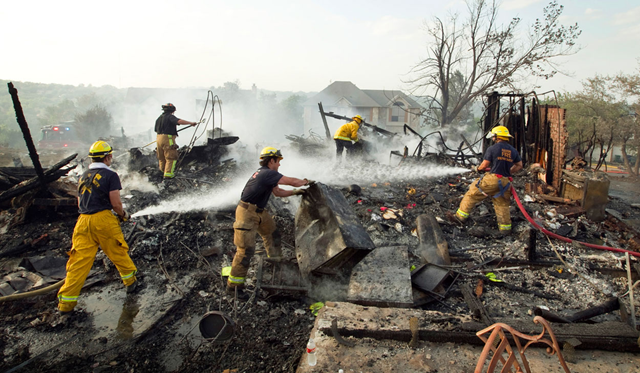Texas wildfires: Is drought the new climate?
By Julie Cart
7 September 2011 The litany of misery playing out in Texas is tough to watch but less difficult to predict. Well before the contagion of wildfires was sparked this week, the state had been experiencing a weather catastrophe. Texas has seen its driest consecutive months since record-keeping began in 1895. Parts of the state have had no measurable rain in nearly a year. The drought, warn officials from the National Weather Service, may continue into next year. A brutal heat wave has tormented residents, with some cities experiencing 100-plus degree weather for more than a month. Texas Gov. Rick Perry, a GOP presidential candidate, scoffs at the notion of human-induced climate change, even suggesting recently on the campaign trail that scientists are manipulating data to make money. He also has declared a weather-related state of emergency every month since December. Meanwhile, Texas’ state climatologist has warned that his fellow citizens should get used to this new climate of extremes. These horrible fires are driven by wind, to be sure, but are fueled by much more combustible decisions: fire-prone nonnative plants planted to benefit another nonnative — cattle. Rampant urban incursions into wildlands, placing homes in danger. Private property owners’ failure to manage the grasses and trees on their land. A budget-cutting policy that pared most of the state’s volunteer firefighters. Climate-watchers are reminding Perry that Texas’ nightmare is a direct result of a political decision to ignore the reality of climate change, leaving the state unprepared for its devastating effects on public health, the livestock and agriculture industries, and, ultimately, the sustainability of life in the arid Southwest.
Texas wildfires: Is drought the new climate? 
By Ben Wermund; Editing by Corrie MacLaggan and Peter Bohan
19 May 2011 AUSTIN, Texas (Reuters) – Texas lawmakers are set to slash funding for the agency responsible for fighting wildfires in the midst of a historic wildfire season in which some 2.5 million acres have burned. The Texas Forest Service faces almost $34 million in budget cuts over the next two years, roughly a third of the agency’s total budget. The cuts are in both the House and Senate versions of the proposed state budget. The Forest Service has about 200 firefighters and offers assistance grants to volunteer fire departments. Assistance grants are likely to take the biggest hit. Volunteers — two of whom were killed in fighting this year’s fires — make up nearly 80 percent of the state’s fire-fighting force and are first responders to roughly 90 percent of wildfires in Texas. “Volunteer programs are our No. 1 defense,” Forest Service Director Tom Boggus told Reuters. Since 2002, the Forest Service has given out $153 million in grants, which have paid for 44,000 sets of protective clothing, 1,200 fire engines and funded the training of about 34,000 firefighters. […] But Texas, which has a two-year budget cycle, has a shortfall of up to $27 billion for 2012-2013. Talmadge Heflin, director of the Center for Fiscal Policy at the conservative Texas Public Policy Foundation, said everybody should share in the cuts. […]
